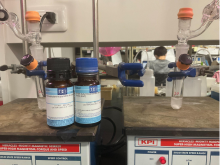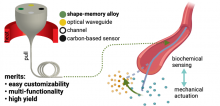Medicine
News
02 Mar 2023
Lipid nanoparticles have been used to encapsulate CRISPR-Cas9 and deliver it to cells in mice, where it was highly effective at knocking down expression of a target protein.
01 Mar 2023
Brain shrinkage patterns tied to low trust have links to depression vulnerability that can alert to its early detection even before symptoms appear.
28 Feb 2023
A new apparatus uses electromagnets to remotely control guidewires through tiny, tortuous blood vessels for the treatment of cardiovascular diseases.
27 Feb 2023
Scientists at Tokyo Medical and Dental University have discovered a new type of bone repairing material that could be used to more precisely fix bone defects.
23 Feb 2023
This year’s roster is the third cohort to be inducted into the Hall of Master Academic Clinicians, an honour conferred on exceptional clinician-educators at the SingHealth Duke-NUS Academic Medical Centre.
17 Feb 2023
Antimicrobial resistance is a global public health threat. Asia Research News has prepared a resource for journalists to find stories and connect with scientists combating antimicrobial resistance.
16 Feb 2023
Amide bonds are important functional groups in medicinal chemistry and account for roughly 16% of all reactions performed in drug-discovery research. Some amide bond reactions using pharmaceutically important nitrogen-containing heterocyclic compounds, such as indole, carbazole and pyrrole, rather than amines are not efficient using conventional production methods. In a recent study, a team of leading chemists developed a novel one-pot reaction to efficiently form amide bonds using low-reactivity, nitrogen-containing heterocyclic compounds and carboxylic acid without special equipment or heat.
09 Feb 2023
A research team led by an associate professor at Tohoku University has developed a microscopic fiber equipped with actuators and biochemical sensors. The breakthrough could be used to develop smart catheters and lead to further advancement in robotics.
08 Feb 2023
Hokkaido University researchers have developed a novel method to design and develop peptide antibiotics in large numbers, which will prove critical to controlling antibiotic resistance.
02 Feb 2023
Blocking an immune-regulating protein reverses the damage caused by acute and chronic kidney disease, a preclinical study suggests.
02 Feb 2023
A new microscopic technique allows for the real-time study of RNA G-quadruplexes in living cells, with implications for the fight against amyotrophic lateral sclerosis.
30 Jan 2023
Researchers from Osaka University compared the sensitivity of rapid antigen tests (RATs) and polymerase chain reaction (PCR) tests for the Omicron variant of COVID-19 using data produced by the Japan Professional Football League. They found the comparative sensitivity of RATs for Omicron was not affected by the duration from the onset of symptoms to testing.
27 Jan 2023
New research found that periodontitis, a common gum infection known to worsen other systemic diseases, could also be linked to atrial fibrosis — potentially clarifying its previously unknown connection with atrial fibrillation.
25 Jan 2023
Researchers from Osaka University have identified a protein, FER1L5, that is essential for sperm to acquire fertilizing ability. Sperm from mice lacking this protein were unable to undergo the “acrosome reaction”, which releases molecules that facilitate fertilization, resulting in impaired male fertility. As FER1L5 is also present in human sperm, this work may lead to new diagnostic methods and treatments for male infertility in humans.
20 Jan 2023
Asia Research News monitors the latest research news in Asia. Some highlights that caught our attention this week are a stem-cell based therapy for pets with cancer, how meditation could affect our gut microbiome, and an edible mushroom that contains a deadly nerve gas.
19 Jan 2023
Researchers at Kanazawa University report in Nano Letters how high-speed atomic force microscopy can be used to assess the effectivity of spike-neutralizing antibodies for preventing COVID-19. The use of such antibodies offers a promising alternative to vaccines.
19 Jan 2023
Imagine if your t-shirt could take your sweat and analyze it for health abnormalities. Well, this is much closer to reality after a recent breakthrough by a research group led by a Tohoku University assistant professor. The group created the first microelectronic fiber with microscopic parameters that is capable of analyzing electrolytes and metabolites in sweat.
13 Jan 2023
Asia Research News monitors the latest research news in Asia. Some highlights that caught our attention this week are the growing trend of unique name pronunciations in Japan, an aquarium that can tell you about which fish you are looking at, and which professional baseballs are slipperiest.
13 Jan 2023
Researchers led by Osaka University demonstrated the role of endothelial cell-specific protein Roundabout4 (Robo4) in the reduction of vascular permeability and mortality in mouse models of severe infection. The research team identified a drug inhibitor that increased Robo4 expression and reduced mortality in sepsis and SARS-CoV-2 mouse models of infection. These findings may aid in the development of drugs to reduce the mortality rate of severe infectious diseases.
04 Jan 2023
Researchers from Osaka University found that dietary supplementation with tricaprin results in coronary artery plaque regression and resolution of symptoms in patients with triglyceride deposit cardiomyovasculopathy, a treatment-resistant form of coronary artery disease. These findings represent a conceptually novel treatment for coronary atherosclerosis that paves the way toward establishing a multi-faceted approach to caring for patients with this condition.
23 Dec 2022
Asia Research News monitors the latest research news in Asia. Some highlights that caught our attention this week are how a wasp uses its genitals to defend itself, a compound commonly found in mushrooms that could delay cognitive decline, and sunshine as a cure for myopia.
23 Dec 2022
The ability to see what’s happening inside the body in real-time and at a high resolution is a capability that ultrasound grants orthopedists at a low cost to patients. Ultrasound-guided diagnosis, however, remains relatively new in the field. Dr. Yuko Nakashima is here to change that for Japan with the help of her fellow “e-girls.”
22 Dec 2022
A research team led by Osaka Metropolitan University has revealed a difference in neural activity in response to visual food stimuli, depending on whether those stimuli are presented consciously or unconsciously. Using a questionnaire to assess the study participants, the team found that this difference was associated with their scores on eating behaviors, including emotional eating and cognitive restraint of food intake. These results indicate that eating behavior cannot be understood without taking into account both unconscious and conscious neural processes.
20 Dec 2022
Researchers have designed and synthesized analogs of a new antibiotic that is effective against multidrug-resistant bacteria, opening a new front in the fight against these infections.
19 Dec 2022
Researchers from Osaka University found that the “belief in just deserts”, which is the idea that infected individual deserves to be infected, was associated with attitudes about government restrictions during public health emergencies in the context of the COVID-19 global pandemic. This information could lead to new strategies for combating discrimination, prejudice, and stigma against COVID-19 patients.
19 Dec 2022
A research team led by Hong Kong Baptist University (HKBU) has identified a molecular target for bone anabolic therapies using a selected aptamer that serves as an inhibitor of sclerostin, a protein that prevents bone growth. The discovery offers hope for the development of an effective next-generation treatment for osteoporosis and osteogenesis imperfecta that is free of cardiovascular risk compared to the marketed antibody drug.
19 Dec 2022
Researchers from Osaka University have developed a culture system using pluripotent cells from southern and northern white rhinos, which was refined to produce primordial germ cell-like cells (PGCLCs). These cells are the equivalent of primordial germ cells, the origin of eggs and sperm. The study marks an important first step in the potential production of northern white rhino gametes, which could be used in breeding programs, and is the first to induce PGCLCs in a wild animal.
16 Dec 2022
Scientists developed a novel device that predicts whether an ICU patient taken off mechanical ventilation is likely to suffer from respiratory emergencies, helping critical care teams to provide immediate life-saving interventions.
Events

26 Oct 2009
The 3rd National Conference on Infectious Diseases (3rd NCID) is for health-care workers and researchers in the management of infectious disease.

30 Jun 2009
What is the future for science reporting? The 6th World Conference of Science Journalists invites you to debate, influence, share experience and excellence, develop skills, network, and enjoy all that London has to offer.

21 Mar 2009
Singapore - This conference will engage basic and clinical scientists, including human geneticists, genome scientists, computational biologists, and experts in pathogenic microbial agents to chart the effects of genomics on questions in global infectious disease management.

02 Feb 2009
Ahmedabad 382210, India - The 2009 meeting aims to bring together the scientific community from across the world, both from academia and industry, to deliberate upon unmet medical needs, new research initiatives, etc., to combat these global epidemics.

04 Nov 2009
The 2nd Middle East Congress of Age, Ageing, and Alzheimer’s will bring together a network of key players, renowned scientists and professionals representing all the following fields of gerontology and geriatrics

02 Dec 2008
With the theme "Biotoxins from nature to human diseases", this meeting aims to bridge fundamental researches and clinical studies on problems related to poisons.

13 Oct 2008
Sydney, NSW, Australia - The World Vaccine Congress Australia 2008 offers a unique opportunity to get a complete and up to date picture on developments within the local and global vaccine industry.

20 Oct 2008
UP Manila, Philippines - The theme of the conference is "Resiliency in the face of conflicts and social inequities in the Asia Pacific region".

22 May 2009
Macau, China - This global conference and exhibition will bring together ideas, suppliers and solutions in the field of aesthetic, anti-aging medicine and medical spa, enabling professionals to learn about ageing management.

20 Oct 2008
Mumbai, India - The conference bring together CEOs, therapeutic area experts, top scientists, R&D heads, investors, regulatory experts and business executives from India, the USA and Europe.

22 Oct 2008
Beijing, China - Molecular diagnostics has been emerging as a field that promises to renew technological progress in the clinical laboratory and vastly improve patient care.

09 Sep 2008
Shanghai, China - MEDTEC China is positioned to be a dynamic force in advancing the industry's manufacturing infrastructure to enable in-country design and production of the full range of medical products.

05 Sep 2008
Delhi, India - Health India Expo is a comprehensive showcase of opportunities emerging in India's burgeoning healthcare sector. The health care sector in India offers abundant collaboration opportunities for companies and medical practitioners from all over the world.

01 Dec 2008
The first annual world vaccine Congress will bring you the No. 1 largest speaker clusters and most influential vaccine event program in vaccine meeting history across the world. It aims at building a complete network for whole vaccine world.

22 Jul 2008
Serdang, Malaysia - This is an international symposium to provide higher education and training to neurosurgeons, neurosurgical trainees, nurses and paramedical personnel in the Southeast Asian region.

15 Oct 2008
Phuket, Thailand - The Conference will serve as a forum for exchanging comprehensive information, practical experience, new skills and techniques and for conceptualizing and integrating approaches to the prevention and control of the disease.

03 Sep 2008
UP Manila, Philippines - This conference is intended to be a venue to formalize networks and linkages among nurse researchers and research-based nursing institutions in the region.

12 Jul 2008
The sessions include "Promise and problems of molecular targeted therapiesin children: Lessons from Hedgehog pathway inhibitors", "Regeneration of the damaged Central Nervous System", "Imaging cognition and genetics" and "Aquaporin water channels: from atomic structure to clinical medicine"

16 Nov 2008
The conference aims to provide scientists and executives from academia, and pharmaceutical companies, with the detail information on drug development from natural products and traditional medicines.

11 Jun 2008
The British Nobel Laureate Lecture Series, a collaboration between Keio University and the British Embassy, commemorates the 150th anniversaries of the founding of Keio University, and the initiation of UK- Japan diplomatic relations. Four lectures will be held as a part of Keio's 150th Anniversary Commemorative Project and UK-JAPAN 2008.

10 Jun 2008
New York, USA - The United Nations will convene a Global Leaders’ HIV/TB Forum this June in an effort to boost UN's collective capacity to drive down HIV-associated TB deaths.

05 Jun 2008
Fujian, China - Interherb is the ideal location for industry practitioner to source for international and local healthcare products.

21 Oct 2008
KL, Malaysia - This seminar aims to increase the awareness and
potentials of researchers, academicians, private sector,
entrepreneurs and policy makers towards a greater concerted
effort for the advancement of herbal research and industry.

01 Oct 2008
Manila, Philippines - The conference will tackle issues brought about by the changing global health scenario and consequent challenges to education in the health professions.

25 Jun 2008
Sarawak, Malaysia - This conference invites international speakers to share their knowledge and expertise in evidence-based practice with nurses and other allied health professionals to enhance the quality of patient care.

18 Jun 2008
The 2nd USM Penang International Postgraduate Convention 2008 will be held from the 18 - 20 June 2008 at Universiti Sains Malaysia. Postgraduate students and researchers are invited to attend. Early bird registration ends on 15 May 2008.

01 May 2008
Melbourne, Victoria, Australia - The event focuses on Brain Impairment and Ageing. A range of other topics will be included.

01 May 2008
Gold Coast, QLD, Australia - The theme for the main meeting is Sun Surf Scintillation. The theme for the Pre-Meeting Symposium is Balls, Breasts and Photons.

05 May 2008
KL, Malaysia - this meeting will serve to promote the advancement of scientific knowledge and research in all aspects of nephrology, enhance cooperation and forge stronger links among all the members of the nephrology community.

25 Jun 2008
Kuching, Sarawak, Malaysia - The conference aims to promote the use of evidence in nursing to ensure quality care is delivered to the clients in an increasingly complex and challenging health care environment.
Researchers
Sorry, no researchers coming up for this topic.
- « first
- ‹ previous
- 1
- 2
- 3
- 4
Giants in history
Michiaki Takahashi (17 February 1928 – 16 December 2013) was a Japanese virologist who developed the first chickenpox vaccine.
Irene Ayako Uchida’s (8 April 1917 – 30 July 2013) strides to understand genetic diseases such as Down syndrome paved the way for early screening of chromosomal abnormalities in foetuses.
Baron Kitasato Shibasaburo (29 January 1856 – 13 June 1931) was a Japanese physician and bacteriologist whose work led to a new understanding of preventing and treating tetanus, diphtheria and anthrax.
Maggie Lim (5 January 1913 – November 1995) was a Singaporean physician who promoted family planning and expanded the access to clinics to improve the quality of life for mothers and children in Singapore’s early days.
By isolating soil microorganisms and studying the compounds they produce, Satoshi Omura (born 1935) discovered almost 500 organic compounds with unique properties that were produced by these microorganisms, including many new antibiotics.
The founder of the Adyar Cancer Institute in India, Muthulakshmi Reddy (30 July 1886 – 22 July 1968), fought to uplift women and girls from impoverished situations.
Chinese-American virologist and molecular biologist Flossie Wong-Staal (27 August 1946 – 8 July 2020) was the first scientist to clone HIV and determine the function of its genes.
Maharani Chakravorty (1937 – 2015) was one of India’s earliest molecular biologists whose research paved the way for advances in the treatment of bacterial and viral infections.
Archana Sharma (16 February 1932 - 14 January 2008) conducted research into plant and human genetics that expanded the understanding of both botany and human health. In relation to botany, she uncovered the means by which asexually-reproducing plants evolve into new species.
The first Thai woman to receive a degree in medicine, Margaret Lin Xavier (29 May 1898 – 6 December 1932), is best remembered for her compassion towards her less privileged patients.
In 1915, pathologist Katsusaburo Yamagiwa and his research assistant Koichi Ichikawa became the first to prove that chronic exposure to chemicals can cause cancer.
In 1915, Koichi Ichikawa along with pathologist Katsusaburo Yamagiwa became the first to prove that chronic exposure to chemicals can cause cancer.
Husband and wife team, Kimishige (3 December 1925 – 6 July 2018) and Teruko Ishizaka (28 September 1926 – 4 June 2019) discovered the antibody class Immunoglobulin E (IgE) that triggers allergic reactions. They also discovered that IgE antibodies attach to white blood cells, known as mast cells, releasing histamine, which causes allergic reactions.
Husband and wife team, Kimishige (3 December 1925 – 6 July 2018) and Teruko Ishizaka (28 September 1926 – 4 June 2019) discovered the antibody class Immunoglobulin E (IgE) that triggers allergic reactions. They also discovered that IgE antibodies attach to white blood cells, known as mast cells, releasing histamine, which causes allergic reactions.
Japanese chemist Takamine Jokichi (3 November 1854 – 22 July 1922) founded the Tokyo Artificial Fertilizer Company, where he isolated a starch-digesting enzyme (named takadiastase) from the fungus Aspergillus oryzae.
Ground-breaking cancer researcher Kamal Jayasing Ranadive (8 November 1917 – 11 April 2001) advanced the understanding of the causes of leukaemia, breast cancer and oesophageal cancer through the use of animal models. She was also among the first to recognise how susceptibility to cancer is linked to tumour-causing interactions between hormones and viruses.
The research of Filipino pharmaceutical chemist Luz Oliveros-Belardo (3 November 1906 – 12 December 1999) focussed on essential oils and other chemicals derived from native Philippine plants.
Thai physician and conservationist Boonsong Lekagul (1907 – 1992) made major contributions to the preservation of his country’s wildlife.
Indian scientist and physician Upendranath Brahmachari (19 December 1873–6 February 1946) is best known for creating a drug called Urea Stibamine, used to safely and reliably treat visceral leishmaniasis (or Kala-azar), a severe infection caused by the Leishmania parasite.
Filipino chemist and pharmacist Manuel A. Zamora (29 March 1870 – 9 July 1929) is best remembered for his discovery of the tiki-tiki formula to combat beriberi, a disease caused by Vitamin B1 deficiency.
Korean parasitologist Seung-Yull Cho (16 November 1943 – 27 January 2019) is remembered largely for his pioneering works to control infections caused by helminthic parasites and his contribution to journal publishing.
Fe Villanueva del Mundo (27 November 1911 – 6 August 2011) was a Filipina paediatrician who founded the Philippines’ first paediatric hospital.
After witnessing death and suffering as a youth in his home village during World War II, Nguyễn Tài Thu (6 April 1931 – 14 February 2021) set his sights on alleviating pain by becoming a doctor. After studying Traditional Chinese Medicine in China in the 1950s, Thu returned to Vietnam to serve in military hospitals. Eventually, he became the country’s foremost practitioner of acupuncture, a technique he first learned by inserting needles into himself.
Minoru Shirota (April 23, 1899 – March 10, 1982) was a Japanese microbiologist who invented the popular fermented drink Yakult.
Wu Lien-teh (10 March 1879 – 21 January 1960) was a Malaysian-born doctor who invented a mask that effectively suppressed disease transmission. Winning the prestigious Queen’s Scholarship enabled Wu to become the first Chinese student to study medicine at the University of Cambridge.
David T. Wong (born 1936) is a Hong Kong-born American neuroscientist who is best known for discovering the antidepressant drug fluoxetine, better known as Prozac.
Indian organic chemist Asima Chatterjee (1917 to 2006) studied the medicinal properties of plant products, especially compounds known as vinca alkaloids.
Chika Kuroda (24 March 1884 – 8 November 1968) was a Japanese chemist whose research focussed on the structures of natural pigments.
Umetaro Suzuki (7 April 1874 – 20 September 1943) was a Japanese scientist best remembered for his research on beriberi, a disease caused by vitamin B1 deficiency, characterized by limb stiffness, paralysis and pain.
Salimuzzaman Siddiqui (19 October 1897 – 14 April 1994) was an artist and chemist from Pakistan whose research focused on natural products from plants.
Barry Paw (29 August 1962 – 28 December 2017) was a biologist and oncologist who discovered several novel genes and their functions in red blood cells.
Syed Qasim Mehdi (13 February 1941 – 28 September 2016) was a Pakistani molecular biologist who was a founding member of the Human Genome Diversity Project (HGDP), which assessed human diversity by studying human migration, mutation rates, relationships between different populations, genes involved in height and selective pressure.
Tsai-Fan Yu (1911 – 2 March 2007) was a Chinese-American physician and researcher who was the first female full professor at Mount Sinai School of Medicine. She discovered that gout, a condition characterized by the painful inflammation of joints, was caused by elevated levels of uric acid in the bloodstream.
Min Chueh Chang (10 October 1908 – 5 June 1991) was a Chinese-American biologist who studied fertilization in mammalian reproduction.
A Japanese surgeon, Tetsuzo Akutsu (20 August 1922 – 9 August 2007) built the first artificial heart capable of keeping an animal alive.
Ogino Ginko (3 March 1851 – 23 June 1913) was the first registered female doctor to practise modern medicine in Japan.
Esther Park (1877-1910), born Kim Jeom-dong, was the first female Korean physician to practise modern medicine in Korea and trained the first generation of Korean female doctors.


































































